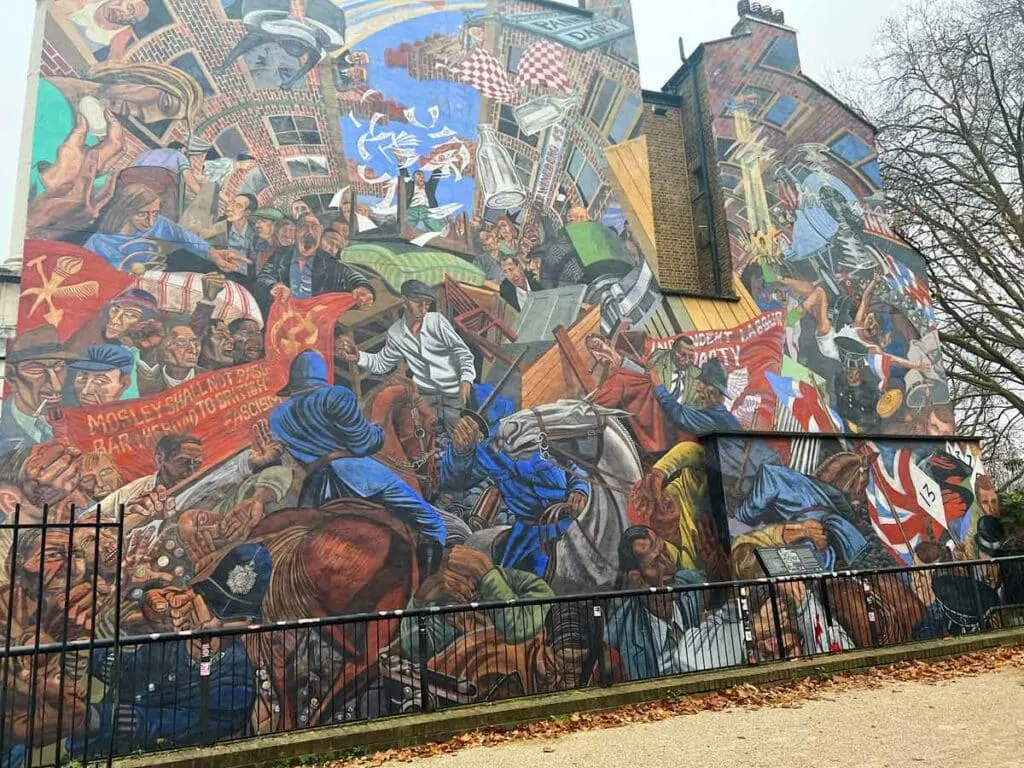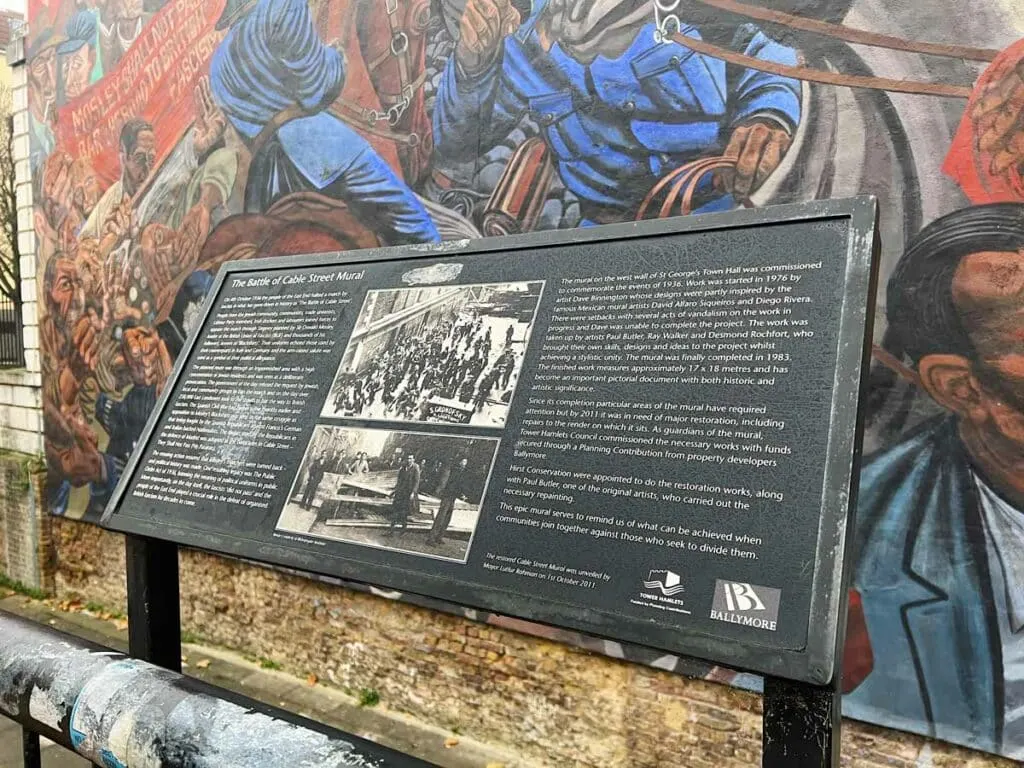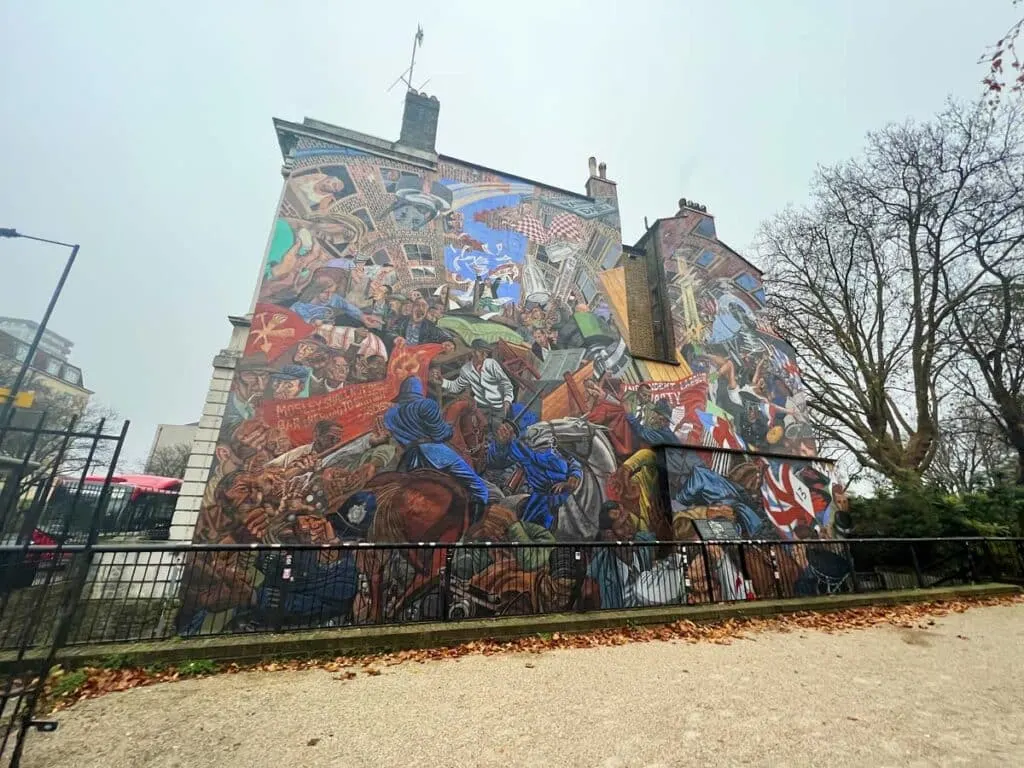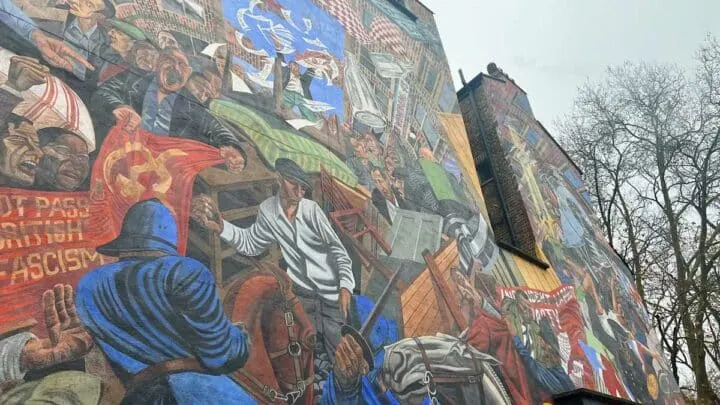The Battle of Cable Street is a vital part of London history. Read on to discover more about the fight to keep the East End free of fascists, and the legacy that still stands today.
Fascist and antifascist clashes aren’t just the hallmark of contemporary American politics. They’ve happened right here on London’s streets.
Though, when they happened here it wasn’t in protest to an orange-faced real estate agent’s white house philandering, but the very real threat of Adolf Hitler.
The events that unfolded at the Battle of Cable Street would shape the way the UK handled fascism and set the groundwork for people across Europe trying to resist it.
The legacy rings as true today as it did then, and a walk down Cable Street to check out the mural in the battle’s memory is a perfect chance to explore it.
Why Visit Cable Street?

To see a mural of an important event in Britain’s antifascist history, and to walk in the footsteps of its heroes.
The Battle of Cable Street is remembered as the moment Britain stood up against fascism in its borders. The events of October 4th 1936 directly led to the passing of the Public Order Act which banned the wearing of political uniforms in public.
Go and check out a slice of history.
The History of The Battle of Cable Street

The Battle of Cable Street is the upshot of two major themes of the era, the rise of fascism, and antisemitism, set to the grim beat of a global economy struggling from the Great Depression, of Hitler’s growing military strength and the clip of fascist military boots in Spain.
Fascism was gaining power in England too. At its helm, a man named Oswald Mosley, leader of the BUF or British Union of Fascists. By 1936 their membership numbered over 40,000.
With their growing voice, and voices in Europe, antisemitism was rife. Jews were blamed for the great depression, and at once painted as greedy capitalists and devious communists.
It would not have been uncommon to hear elected officials say the kind of things that have caused every sponsor to drop and run for cover from Kanye West.
The Battle
Oswald Mosely, backed by Benito Mussolini in Italy and elements of the British political establishment, decided to launch a fascist march through the streets of London. The march planned to cut through the East End, a part of London with a strong Jewish community.
This was no mistake. The march was intended as an out and out display of the antisemetic politics that underpins fascist ideology. Hundreds of thousands of Londoners petitioned government not to let the march happen, but blocking it was deemed antidemocratic and so it got the go ahead.
On October 4th 1936, Moseley and 2,000 fascists gathered to take to the streets, but what they found as they set off for the East End was a unified mob of locals who had banded together to block their route.
The group was 100,000 strong, made of locals, Jewish people, communists, and trade unions. They’d blocked the streets using overturned trucks and debris. Sympathetic tram drivers had even left their vehicles in the middle of the roads as obstacles.
Mosley’s marchers set off with 6,000 policemen as an escort and when they reached the barriers things turned ugly. Fights broke out in several areas but most severely along Cable street where mounted police attacked the antifascists with truncheons.
The police were pelted with rotten fruit, bricks and bottles by the East Enders. Local cafes were turned into aid stations to treat injured defenders. Even children mucked in, rolling marbles under the hoofs of horses.
Luckily no one was killed. The fascist were put off though and, after much entreatment from the police, were forced to redirect the march to Hyde Park instead, to avoid further conflict.
By the end of the day 79 antifascists had been taken into custody, many of whom had been beaten by police. Only six fascists were arrested.
Legacy
Just two days after the Battle of Cable Street Mosley was in Germany getting married. And yes, Hitler was at his wedding.
Things didn’t look up for the BUF for much longer after that. Disappointed with the results of their march, Musolini withdrew his support from the BUF.
By 1940 the group had been disbanded by law for treason, its members rounded up and, Mosley included, sent to prison. The slogan of the day: “they shall not pass” lived on to be the antifascist mantra of the Spanish civil war, and perhaps to inspire the immortal words of Gandalf.
The Mural

Today Cable Street has a very visual reminder of the events of the day. It comes in the form of a mural painted on the side of a building near where the battle took place.
The work for the mural began in 1976 when artist Dave Binnington was given Arts Council funding for the project. He began by interviewing local residents to get details about the day from people who were there.
Binnington began painting in 1979 but the project was more complicated than he imagined and stalled several times, eventually Binnington abandoned the mural after it was vandalised with fascist slogans, causing him to lose hope.
Work was picked up 1982 by Paul Butler, Ray Walker and Desmond Rochfort who had worked with Binnignton before. They finished his design and removed the defaced sections, eventually painting over them entirely.
Today the battle of Cable Street Mural stands in all its fisheyed glory, a coat of special varnish on it to protect it from further damage. You can visit it at the address below.
Cable Street Mural: Practical Information
Address: 236 Cable Street E1 0BL
You can see the Cable Street Mural for free anytime of the day. Shadwell is the nearest DLR station.

